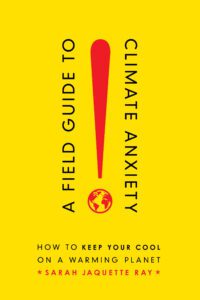The following is a guest article written by Green Schools Quest, February 8, 2023 Connect on the Quest panelist, Dr. Sarah Jaquette Ray author of, “A Field Guide to Climate Anxiety: How to Keep Your Cool on a Warming Planet”.
In climate activism, an “urgency trap,” as I call it, bleeds from the corporate sphere into our efforts to heal the world. Amplified by the timelines we hear about various “tipping points” and deadlines for extinction, urgency has become the climate movement’s main strategy. The assumption underlying many climate stories is that urgency + fear = action. But I want to make the perhaps very counterintuitive case that the planet needs us to resist the urgency trap and to resist the productivist ethos of climate activism. That is, perhaps we should do less, go small, and engage in our climate work slower.
So what are the dangers of the urgency trap? We often jump into activity out of the discomfort we feel when we really look at all the suffering and problems in the world. Doing, doing, doing, and trying to go bigger and bigger in our impacts, can become an addictive form of distraction from that grief, pain, anger, and worry. Indeed, Buddhists would say that the productivist culture I’m describing here is at the root of all suffering, including the climate crisis. It is a form of distraction from the pain of our separation from the earth. Rather than face our discomfort and try to address the root of it, we overstimulate our lives and senses and clutter our calendars and closets. This may stroke our dopamine centers of relief, and give us the illusion of being effective, but it’s like the activist version of swiping or shopping our way out of climate despair.
 Urgency keeps us too exhausted to move upstream to fix our problems at their source, constrains our field of action to just putting out the fires right in front of us, and keeps us consuming to numb ourselves from the pain of all of this. Ironically, when we’re in the urgency trap, we’re using the same metric to fight the system that the system has used to destroy life.
Urgency keeps us too exhausted to move upstream to fix our problems at their source, constrains our field of action to just putting out the fires right in front of us, and keeps us consuming to numb ourselves from the pain of all of this. Ironically, when we’re in the urgency trap, we’re using the same metric to fight the system that the system has used to destroy life.
The urgency trap is designed to hijack our nervous systems and bypass reason. Urgency overrides the possibility of a thoughtful pause between a scary stimulus and our response to it. If there’s an immediate threat that needs our attention right away, we are more likely to sidestep thoughtfulness, speed up the otherwise slow processes of figuring out the best approach, and jettison the need for diverse voices at the table.
This myopic urgency can exacerbate the divides between each other and decrease regard for the more-than-human world. The perception that our time is limited keeps us from acting in pro-social and pro-environmental behaviors. (As researchers of the famous “Good Samaritan” study concluded, “ethics become a luxury as the speed of our daily lives increases.”) Urgency makes us impatient with the slow processes of cultivating community, and leads to even further fracturing of relationships. Thus, the question for our climate action isn’t whether we have time or not; the question is how our perception of time scarcity diminishes our effectiveness and increases the harms we cause in the world. Urgency and fear are thus not just bad for our mental health; they are bad for life on the planet.
How do we resolve this? First, we investigate these questions:
-
- Whose interests does it serve for us to feel time scarce?
- What are the effects of our being brainwashed by the myths of productivism and powerlessness?
- Who benefits from us being stuck in the urgency trap?
Certainly not the planet, each other, our relationships, or the more-than-human world.
Second, we should think about action in much broader temporal terms. Change is slow, and the short view of change leaves us with a narrow view of what could count as an action that effects change. In a recent article, Rebecca Solnit put it this way, “Change itself becomes invisible when your timeframe is shorter than that change, and the short-term view breeds defeatism and despair.” The hidden work of social change takes a lot of time, rarely makes the news, and even among activists, is often considered the sideshow to the main event.
Third, we should rest, find stillness, and prioritize healing more. We can follow the theologian, scholar, and artivist Tricia Hersey, whose book, Rest Is Resistance, is a manifesto on the political necessity of being anti-productive. She sees rest as a form of liberation and resistance to oppression:
“My rest as a Black woman in America suffering from generational exhaustion and racial trauma always was a political refusal and social justice uprising within my body. Rest pushes back and disrupts a system that views human bodies as a tool for production and labor.”
Doing less, slower and smaller, is not really about giving up on sustainability. It’s about boycotting the attention economy, which extracts not only our attention, but also material and natural resources. It’s about slowing down enough to gain clarity about strategy. It’s about not donating our bodies, hearts, and minds to forces of extraction and violence, who gladly do their work through us. And, of course, it’s about protecting our energy and mental health so we can stay in this work for the long haul.

Author bio: Dr. Sarah Jaquette Ray is author of A Field Guide to Climate Anxiety: How to Keep Your Cool on a Warming Planet and professor and chair of the Environmental Studies Department at California Polytechnic University, Humboldt. She writes and consults extensively on activism, climate justice, and emotions.
